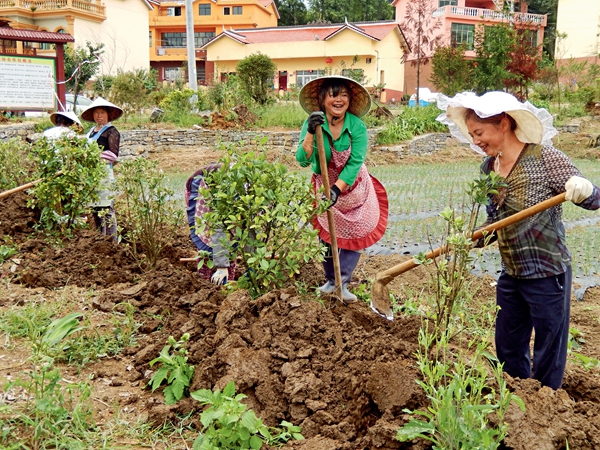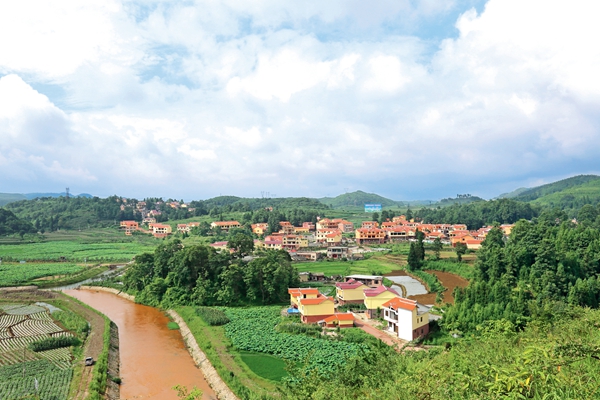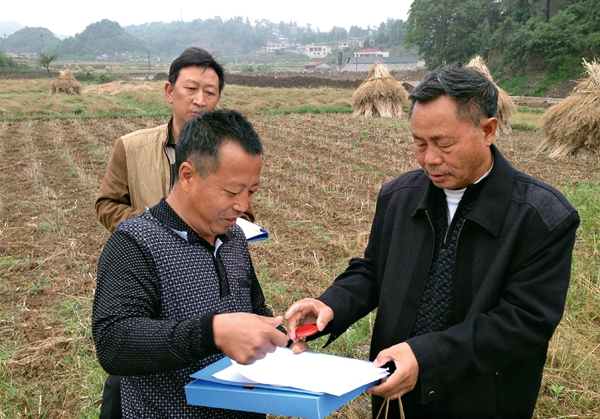By staff reporter ZHOU LIN
By staff reporter ZHOU LIN
CHINA’s southwestern province of Guizhou is one of the most poverty-stricken areas in the country. However, during the 12th Five-Year Plan (2011-2015), 6.56 million people were lifted out of poverty, leaving 3.73 million awaiting a similar release. For the year 2017, Guizhou government set itself the ambitious goal of helping another million people to rise from poverty.
Desire for Change
Tangyue Village, located in Anshun City, Guizhou Province, was formerly a poverty-ridden village with a collective economy of less than RMB 40,000 and an annual income of no more than RMB 4,000 per capita. Dependent on traditional farming, the villagers could barely eke out a subsistence.

Zhang Fuyou and his two brothers lived in this small village and farmed half an acre of land, barely making ends meet. In the late 1990s, 34-year-old Zhang had to leave his home and search, for job opportunities in coastal Zhejiang Province.
After over a decade of wandering and searching for work, Zhang found only casual jobs, and lived hand to mouth. In 2010, 46 years old and homesick, Zhang felt he was too old to do manual work and so returned home.
Everything in the poor village was the same as when he had left it. The sky was crystal blue, some lands had been converged for cultivation, others lay fallow. All were teeming with weeds. Younger villagers had left to find jobs in cities, leaving only the elderly and children in this “empty shell village.”
Dramatic changes took place on June 3, 2014 after an unprecedented flood inundated fields and roads. Zhang recalls how the flood toppled many houses in the village and washed away villagers’ clothes, shoes, furniture, and kitchenware.
The already impoverished village barely surviving on traditional agriculture, had been thoroughly ravaged by the flood. However, as the Chinese saying goes, “extreme poverty breeds a desire for change,” which means things will develop in the opposite direction when they reach an extreme. So it was with Tangyue Village.
Power of the Collective
The head of the village Zuo Wenxue loves reading Chinese literary classics. He was keenly aware that rather than building bridges or running a factory, the most important thing after the devastating flood was to reorganize villagers and give full play to the power of the collective.
June 8, 2014 was an unusual day. Village representatives from 10 natural villages under the jurisdiction of Tangyue Village got together for a meeting. Zuo explained to them how to run the rural cooperative.

“The lands will be concentrated and used according to integrated planning. The village will set up an agricultural production team, a livestock and poultry breeding team, a construction team, a transportation fleet and other professional teams, which will all develop into small companies. Furthermore, a workshop for women will set up to make full use of the surplus labor force. Villagers will choose to work in a team and be paid monthly according to their workload. Villagers who become shareholders by transferring their land-use rights to the cooperative will get the minimum guaranteed asset income based on the contracted price, and may also gain dividends at the end of the year.”
Zuo stressed that this was not a village administrative order to join in the cooperative. All residents could make their own decisions to invest their land as shares in the cooperative, and were free to withdraw on the premise of guaranteeing their contracted land management rights.
Zuo’s proposal was passed unanimously by all 86 representatives at the meeting. The Tangyue Village Cooperative was set up through villagers’ eager desire to rebuild their hometown.
As the village changed, so did Zhang’s life. Zhang has invested the 0.49 acres of farmland as a stake in the village’s cooperative, and in return, his family are paid dividends and rent annually for the land leased to the cooperative. He now works for the village cooperative, earning RMB 150 per day, and his wife does soft manual work for RMB 80 per day. The couple can earn an aggregate annual income of approximately RMB 60,000 in total.
Basking in the sunlight in the brick-paved cultural plaza of Tangyue Village, Zhang told China Today, “All family members are happy now. Both seniors and children can be looked after and couples need not be separated any more. What’s more, they earn much more than before.”
Tangyue’s transformation can be credited to its successful reform of the rural property system which encourages the transfer of land-use rights and profit sharing with farmers under a joint stock operation model. However, the process demands arduous and meticulous work, including measurement of farmer’s contracted land, registering the land area, file making and public information bulletins that enable villagers’ supervision. Eventually, the local government issues the certificate of land management rights to farmers, known as “verification of land-use rights.”
The collective ownership of rural land is one of the greatest institutional achievements of the CPC since the founding of the People’s Republic of China in 1949. Thereafter land in China’s rural areas was collectively owned and collectively farmed by members of people’s communes. In the early 1980s, after the reform and opening-up policy was introduced and people’s communes were abolished, land was contracted to individual farming households. This arrangement was believed to empower farmers, and has effectively increased agricultural production efficiency. But in recent years, it has been questioned on grounds of constraining economic efficiency, because it hampers scale production. Tangyue Village creatively concentrated scattered lands from farmers and readjusted the production and industrial structure in the pursuit of large-scale development, to meet the needs of dramatically improved productive forces after 30-plus years of reform.
Rural Property Rights Reform
Farmer’s land-use rights were not the only rights ratified. Other rights included forest management rights, collective ownership of land, collective construction land-use rights, ownership of housing, the property of small-scale water conservancy projects, and rural collective property rights. All of these efforts promote the reform of the rural property rights system.

The forest coverage rate in Tangyue Village has reached 76.4 percent. After verifying the forest management rights, over 300 acres of forest have been allocated to raise two million free-range chickens. The village collective is preparing to construct a zero-pollution spring water factory where women can work. In addition, a modernized hoggery and a septic tank are under construction, which will adopt the water and fertilizer integration system to provide organic fertilizer for 49.42 acres of vegetables.
After three years of development, 90 percent of farmers have become members of the village collective. And since the verification of the seven rights of farmers, over 692 acres of land were collectively farmed to develop large-scale plantation.
Now, more than 16.47 acres of sponge mushrooms and lotus root are planted respectively, with 49.42 acres of vegetables. And a profit-sharing model splits dividends according to a 3:3:4 ratio among the village, the rural cooperative, and farmers.
In 2016, Longyao Food Group Co., Ltd. of Shandong Province’s Shouguang City partnered with Tangyue Village to offer RMB 7 million as assistance funding, and also invested RMB 4.7 million in the about 50 acres agricultural industrial park which is now under construction. It is expected to earn RMB 6 million annually through the newly built seedling nursery center, high-tech exhibition center, fruit-picking and sightseeing areas, and high-yield planting demonstration areas.
Mobilize All Villagers
The collective economy has expanded rapidly in Tangyue Village. Farmers who lived on traditional agriculture have now established their own agricultural production teams to plant vegetables and trees. They have also organized a transportation company, a construction company, and a water management company. Villagers can choose to join a production team or a company based on their capabilities and wishes. The team leader is selected by villagers themselves and then nominated by the village committee. There are over 80 people working in four agricultural production teams, and at harvest time more than 300 workers are needed, 80 percent of whom are women. One woman can earn RMB 100 working in the paddy field and RMB 80 on farm land. With four rest days in one month, a woman can earn over RMB 2,000.
Luo Guanghui, aged 45, was selected as the team leader of the planting group. He pays great attention to intensive and meticulous farming and introduced standardized production process into the fields. Under his leadership, 0.16 acres of land can produce 3,500-4,000 kg of chilli peppers, earning almost RMB 10,000. The fields can grow Chinese cabbage after the pepper harvest, and earn another RMB 3,000-4,000 a year for 0.16 acres of land.
Every work team has its annual output task to guarantee a basic salary. Luo earns a yearly salary of RMB 50,000. As team leader, he signed a contract with the cooperative to complete a certain amount of work annually, otherwise he will accept a cut in salary. However, if his team exceeds the goals, he can also get 30 percent of the surplus profit. The remaining 70 percent goes to the village collective. Of this, 40 percent is distributed as dividends at the end of the year, 30 percent goes to the rural collective, 20 percent is used as public funding, and the remaining 10 percent goes to the village committee to cover daily expenses.
Changes can be seen everywhere. Before the village cooperative was set up, 30 percent of land in the village was fallowed because so many people had left the village to work elsewhere. Now the fields are all cultivated by women, with about 206 acres of fine fruit, 25 acres of shallow water-planted lotus root, 101 acres of green seedlings, and 50 acres of organic vegetable bases to supply local school canteens. Farmers no longer have to shoulder vegetables in baskets on a pole and bargain at market.
In the construction team, a main worker can earn RMB 300 per day, while an assistant worker gets RMB 120-150. There are altogether 286 people in 12 detachments, including cement finishers, painters, stonemasons, water and electricity installation workers and interior decoration workers, among whom nearly 100 are women.
The transportation team has over 40 people, 60 percent of whom once left the village to work but chose to return. As farmers recently transferred their lands to the village, they were guaranteed a bank loan by the cooperative to buy trucks and mid-size cars. The transportation team now has more than 40 carrier vehicles. Truck drivers can earn around RMB 30,000 per month, while mid-size car drivers can earn over RMB 10,000. In slack periods, they may also find temporary work in other work teams.
As farmers invest their assets, money, and skills in rural cooperatives in return for dividends and rent, and become shareholders, the village cooperative provides more job opportunities to poor farmers and migrant rural workers. Over the last two years, local villagers working in other places have returned, and the number of migrant workers has reduced from 860 to around 50.
Nowadays, when walking around the villa-style houses in Tangyue Village, people can be seen working busily everywhere. Tangyue Bookstore, and JD e-commerce service center and financial service center are the highlights. In this small village, people fond of reading make full use of the national e-commerce platform as a bridge of communication with the outside world.
From Poverty to Moderate Prosperity
Since the vacant land resources were revitalized, farmers became the real owners of the collective economy. They actively participate in the building and development of the village cooperative. The average per-capita net annual income has increased from less than RMB 4,000 in 2013 to RMB 10,030 in 2016. The village, modern and vibrant, has now become an example of a moderately prosperous society to be emulated by other villages.
In Guizhou Province, there are many examples of villagers shaking off poverty and changing their lives for the better. The reform model can be classified as a three-pronged reform system to “change resources into assets, change funds into shares, and change farmers into stockholders.” Guizhou’s distinctive experience, nurtured during the process of national poverty alleviation, has been integrated into the central government’s plan to be popularized in rural areas, so as to strengthen the vitality and vigor of the rural collective economy.
Collective efforts have revitalized lands left barren for years and motivated farmers to rebuild their homeland, lifting them out of poverty and blazing their path from poverty to moderate prosperity.